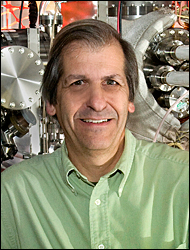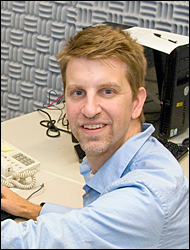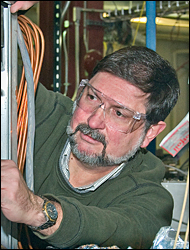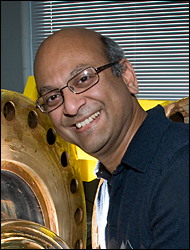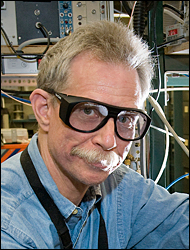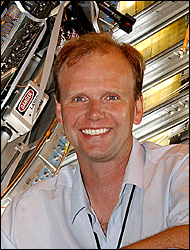Six Brookhaven Lab Scientists Named American Physical Society Fellows
December 17, 2009
UPTON, NY — Six scientists at the U.S. Department of Energy’s Brookhaven National Laboratory have been named Fellows of the American Physical Society (APS), a professional organization with more than 47,000 members. Election to APS Fellowship is limited to no more than one half of one percent of its membership in a given year, and election for this honor indicates recognition by scientific peers for outstanding contributions to physics.
The 2009 Fellows from Brookhaven are:
James Alessi
“For his many groundbreaking contributions to the development of intense negatively charged hydrogen (H-) beam sources, both unpolarized and spin-polarized, and the development of a high intensity Electron Beam Ion Source for the production of beams of high charge state heavy ions.”
Alessi develops ion sources to generate beams of particles used in various accelerators at Brookhaven, including the world-class nuclear physics accelerator, the Relativistic Heavy Ion Collider (RHIC). At RHIC, physicists from around the world study extremely hot, dense matter that is thought to have existed a few millionths of a second after the Big Bang. A new Electron Beam Ion Source now being commissioned will generate heavy ion beams for both the NASA Space Radiation Laboratory at Brookhaven, where researchers assess the effects of high-energy charged particles on biological systems, materials, and instruments in an effort to understand the potential risks of exposure to space radiation, and RHIC. Alessi also developed high-intensity ion sources, such as that used for the Brookhaven Linac Isotope Producer, which makes short-lived radioisotopes that are used as diagnostic, research and calibration agents in hospitals and research institutions.
Alessi earned a Ph.D. in physics from the University of Pittsburgh in 1979 and joined Brookhaven as an assistant physicist in the same year. He became a physicist in 1983, and, after serving as group leader of several Alternating Gradient Synchrotron Department groups, he became group leader of the Collider-Accelerator Department Preinjector Group in 1999, the position he now holds.
Charles Black
“For pioneering contributions to the integration of nanometer-scale polymer self-assembly in the fabrication of high-performance semiconductor microelectronic devices.”
During his career at IBM, Black pioneered the use of self-assembly in nanotechnology to fabricate high-performance semiconductor devices used in microelectronics. Self-assembly is the spontaneous organization of materials into regular patterns. Under controlled conditions, certain materials will self-organize into patterns on the scale of tens of nanometers with dimensions and uniformity unattainable by conventional means. In his current research at Brookhaven’s Center for Functional Nanomaterials (CFN), Black is designing and applying self-assembly approaches to build nanostructured solar cells from low-cost polymer and nanocrystal materials.
Black earned a Ph.D. in physics from Harvard University in 1996, and started his career at the IBM Thomas J. Watson Research Center as a research staff member. In 2006, he joined Brookhaven as a scientist and group leader, managing the CFN’s Electronic Nanomaterials Group. Black has been recognized for his innovative research contributions, including receiving Industry Week Magazine’s Technology of the Year Award in 2004, and IBM’s Outstanding Technical Achievement Award in 2005.
G. Lawrence Carr
“For applications of synchrotron and terahertz radiation to condensed-matter systems.”
At Brookhaven’s National Synchrotron Light Source (NSLS), scientists use light that spans a very wide range of energies along the electromagnetic spectrum, from x-rays to microwaves, to study materials as diverse as computer chips and viruses. The spectral range of light between infrared and microwaves is known as terahertz, which describes the light’s frequency. Carr’s research at the NSLS has demonstrated the importance of terahertz frequencies in studying the electronic behavior of materials such as semiconductors and superconductors.
After earning a Ph.D. in physics from Ohio State University in 1982, Carr joined the faculty of Emory University in the same year. He became a visiting faculty member of the University of Florida in 1989 and then joined Northrop Grumman as a staff scientist in 1990. In 1996, he started his career at Brookhaven as an associate physicist, and he was promoted to physicist in 1998.
Milind Diwan
“For his contributions to neutrino and kaon physics.”
Diwan studies neutrinos, unusual particles that can pass through anything in their path. Neutrinos have intrigued scientists around the world, including Brookhaven Lab chemist Raymond Davis, Jr., who won the Nobel Prize in Physics in 2002 for detecting neutrinos originating in the sun. In particular, Diwan is trying to determine if neutrinos play a part in the asymmetry of matter and antimatter in the universe, a puzzle that has confounded physicists for decades.
Diwan also studies heavy subatomic particles called kaons at Brookhaven’s Alternating Gradient Synchrotron. Kaons spontaneously break down, or decay, in various ways, some of them occurring as infrequently as one in ten billion particle interactions. If these rare kaon decays occur significantly more often than predicted by the Standard Model, the modern physics theory of elementary particles, then new physics will have been discovered.
Diwan earned a Ph.D. in experimental physics from Brown University in 1988 and started his career as a research associate at Stanford University. He then joined the team of scientists working at the Superconducting Super Collider in 1992, and, after that project was cancelled, he came to Brookhaven Lab as an assistant physicist in 1994. He was promoted to associate physicist in 1996 and to physicist in 1999.
Gregory Hall
“For innovative applications of high resolution molecular spectroscopy to photodissociation dynamics, energy transfer and bimolecular reactions.”
Hall works with lasers to understand how molecules collide, exchange energy, react, and break apart. He and his colleagues have developed and applied experimental techniques using very sensitively controlled laser light to measure the flow of energy inside a molecule as it breaks apart. Using this light, he can also measure velocities of molecules, the orientation of rotating molecules, and molecular collisions that lead to chemical reactions or energy transfer between molecules. This information provides a basis for testing theories used in computer models of combustion, which are used, for instance, by combustion engineers to design fuel-efficient and environmentally friendly combustion devices.
Hall earned a Ph.D. in physical chemistry from the University of Toronto in 1980. He then worked as manager of Cornell University’s Facility for Laser Spectroscopy, from 1980 to 1987. He joined Brookhaven as an assistant chemist in 1987, became an associate chemist in 1989, a chemist in 1994, and a senior chemist in 2001.
Thomas Ullrich
“For his leading contributions to the study of electrons, and hadrons containing charm and bottom quarks in relativistic heavy ion collisions.”
Measurements from RHIC experiments have revealed compelling evidence for a new state of nuclear matter created at the extremely high densities and temperatures achieved in heavy ion collisions. This type of matter is believed to have existed just microseconds after the Big Bang. By studying electrons and charm and bottom quarks produced at RHIC, Ullrich has found intriguing hints about the properties of the dense matter created in these collisions.
After earning a Ph.D. in physics from the Ruprechts-Karls-Universität in Heidelberg, Germany, in 1994, Ullrich became a postdoctoral fellow at the university. In 1996, he came to the U.S. as a Lynen-Fellow at Yale University and worked on international collaborations both at CERN, the European Organization for Nuclear Research, and RHIC. He became the physics analysis coordinator of the STAR collaboration at RHIC in 1998, a position he held until 2001. He joined Brookhaven Lab in 2001 and was STAR deputy spokesperson from 2001 to 2002. At Yale, he became a research scientist in 1999, was appointed to associate adjunct professor in 2002, then adjunct professor in 2005.
2009-11057 | INT/EXT | Newsroom




